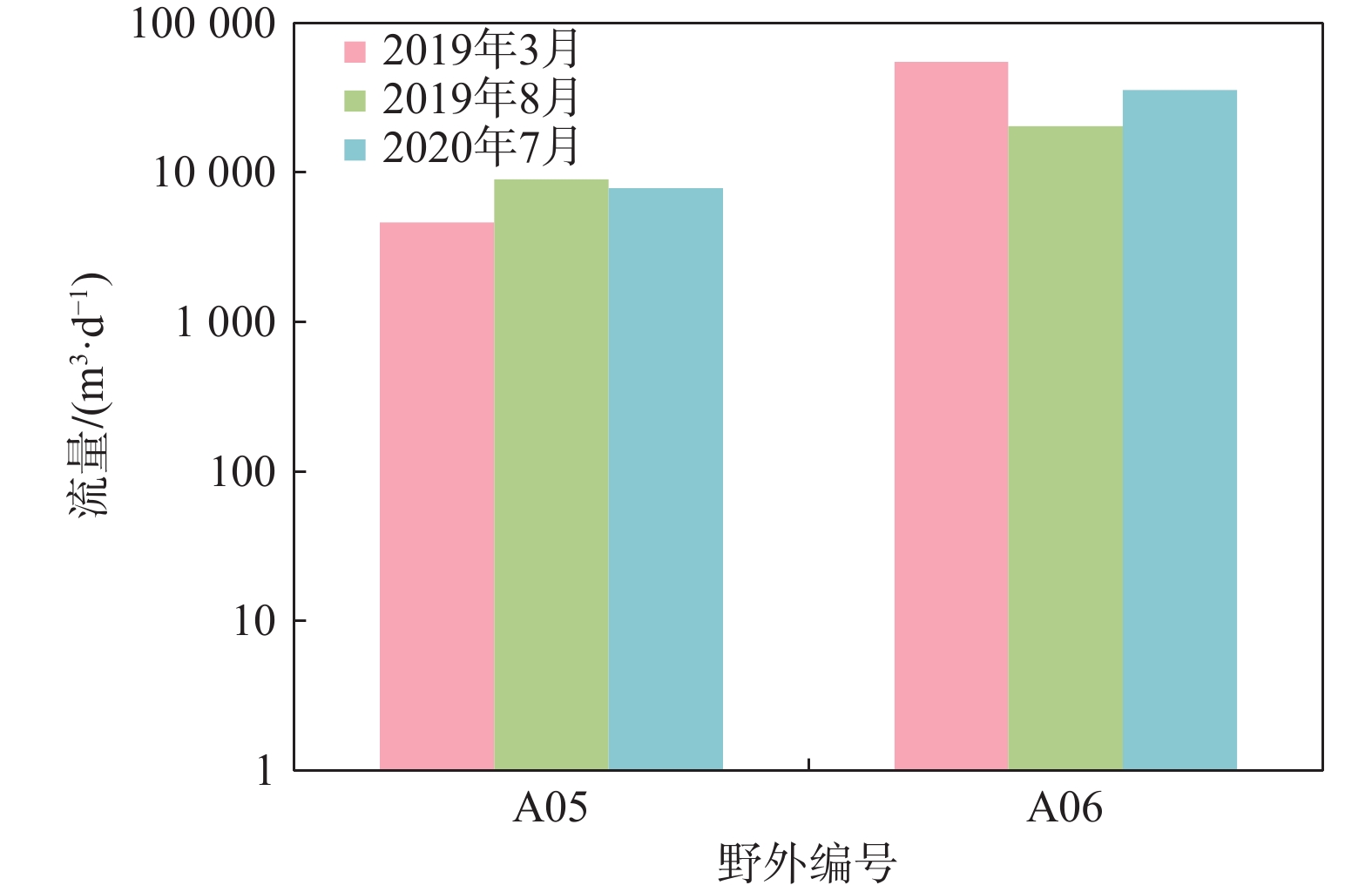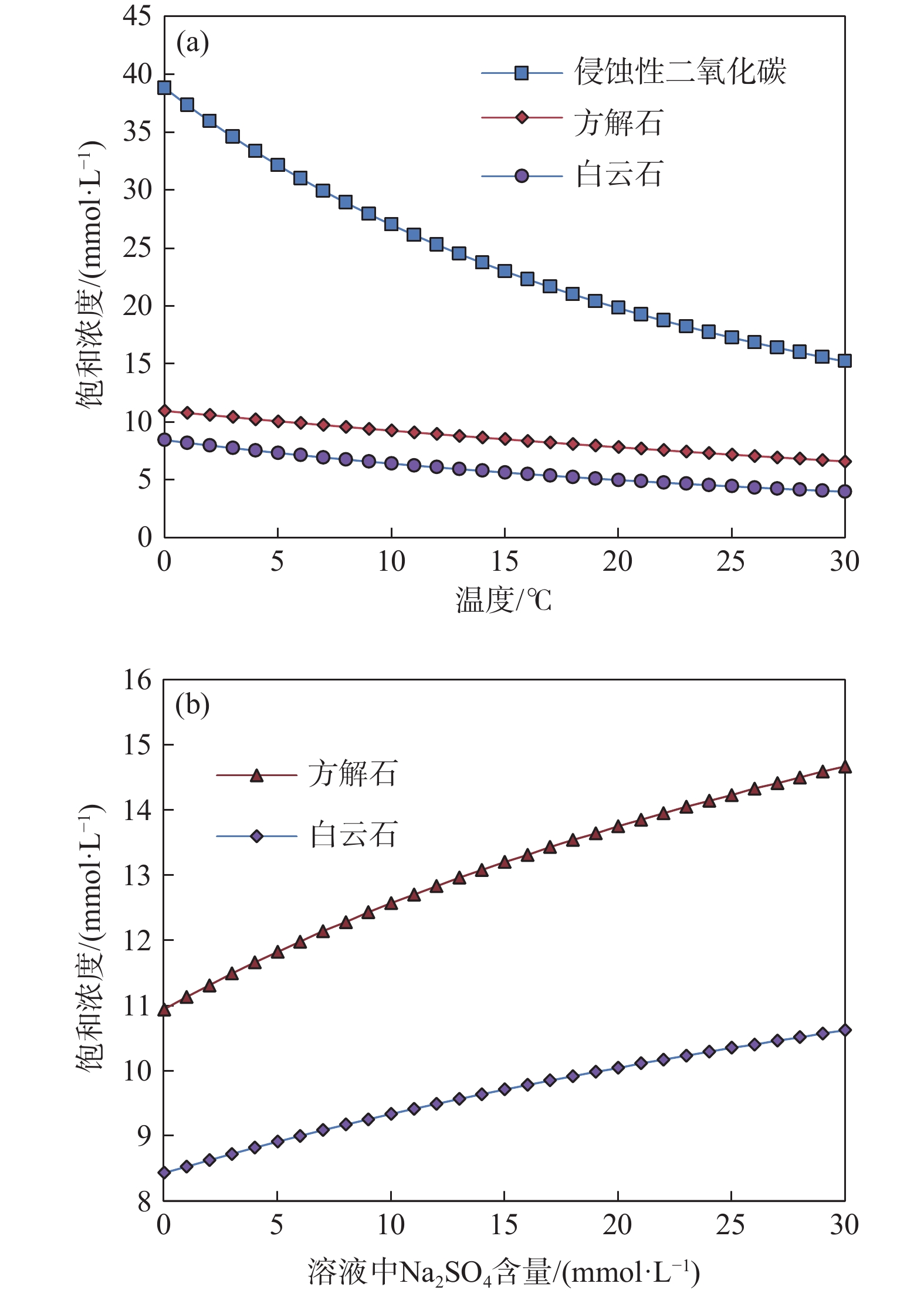Evolution regularity of the plateau tectonic karst and the relevant karst groundwater circulation mode in Mount Genie and Zaya sections along the Sichuan-Xizang Railway
-
摘要:
川藏铁路建设面临高原构造岩溶高压突水突泥重大地质安全风险,开展高原构造岩溶发育规律与岩溶地下水循环模式研究对隧道突水突泥灾害早期预测具有重要意义。文章分析研究了川藏铁路格聂山和察雅段构造岩溶发育规律及岩溶地下水循环模式。研究表明,研究区构造岩溶发育具有明显的层序规律和高程分带性,一至四级岩溶发育区分别形成于中新世之前、中新世晚期至上新世、上新世和上新世至更新世,高程依次为4900~5300 m、4000~4300 m、3700~3800 m和2900~3200 m。活动断裂对岩溶水分布、富集具有明显控制作用,晚更新世以来的活动断裂沟通岩溶发育区段,形成特有的高原岩溶蓄水构造条件。岩溶地下水系统可分为高位补给区、远程管道径流区和集中排泄区,高位补给区位于一级岩溶发育区,三、四级岩溶发育区为岩溶水集中排泄区,常出露流量大于100 L/s的岩溶大泉。岩溶水流系统可分为浅部水流系统和深部水流系统。岩溶大泉主要接受冰雪融水补给,具有水压高、流程长和深循环的动力特征。低温状态下冰雪融水高CO2饱和浓度和
< span class="inline-formula-span" > < span class="inline-formula-span" > ${\rm{SO}}_4^{2-} $ < /span > < img text_id='' class='formula-img' style='display:none;' src='202104005_Z-20210803102053.png'/ > < /span > < img text_id='' class='formula-img' style='display:none;' src='202104005_Z-20210803102053.png'/ > Abstract:Construction of the Sichuan-Xizang Railway may face significant geological safety risks of water inrush and mud inrush in the plateau tectonic karst region. It is of great scientific and practical significance to carry out research on the evolution regularity of the plateau tectonic karst and the relevant karst groundwater circulation mode for the early prediction and identification of the water inrush and mud inrush disaster in the railway tunnel to be built. Based on the field survey and published literatures, this paper makes an in-depth analysis and draws some conclusions. The tectonic karst development shows obvious sequence characteristics and elevation zonation. The first level to fourth level karst development areas were formed before Miocene, late Miocene to Pliocene, Pliocene and Pliocene to Pleistocene, and occur in the elevation range of 4900−5300 m, 4000−4300 m, 3700−3800 m and 2900−3200 m, respectively. Active faults obviously control the distribution and enrichment of karst groundwater. Since the late Pleistocene, active faults have connected different karst areas and formed unique storage conditions for the tectonic karst groundwater in the plateau region. Karst groundwater system can be divided into high recharge area, remote pipeline flow area and concentrated discharge area. The high recharge area occurs in the first-level karst evaluation area, and the third-level and fourth-level are the concentrated discharge area which generally contain the outcropping springs with a discharge of more than 100 L/s. The groundwater system is appropriately divided into shallow and deep groundwater flow system. Karst springs are mainly supplied by ice and snow melting water, and exhibits the dynamic characteristics of the high water pressure, long flow path and deep water groundwater circulation. High CO2 saturation concentration of the melting water and the salt effect of sulfate promote the formation of high TDS sulfuric acid karst groundwater of low temperature.
-
Key words:
- Sichuan-Xizang Railway /
- tectonic karst /
- evolution regularity /
- groundwater /
- water circulation model
-

-
表 1 研究区样品水化学组分及氢氧同位素含量
Table 1. Chemical compositions and hydrogen and oxygen isotope content of the water samples in the study area
研究区 样品类型 水化学组分含量/(mg·L−1) TDS K+ Na+ Ca2+ Mg2+ Cl− 

察雅 温泉 1255 2.40 14.54 271.10 58.9 4.89 754.00 215.40 2051 3.45 35.10 422.10 95.05 5.59 1360.00 263.20 冷泉 159.1 0.45 1.77 48.61 4.70 1.75 14.36 155.40 2562 0.63 5.59 586.20 100.10 2.10 1752.00 203.80 286.5 0.66 3.98 57.95 22.01 1.75 102.30 178.70 地表水 107.40~232.70 1.04~2.37 3.95~13.30 19.33~52.81 4.23~30.08 1.05~1.75 4.31~24.71 110.60~256.60 121.70~273.50 0.67~1.20 3.71~6.11 20.77~61.44 9.67~15.85 1.40~1.75 23.02~107.10 95.71~155.40 格聂山 温泉 1002 18.38 119.60 208.30 26.93 8.73 76.83 476.20 1015.72 15.40 274.00 2.15 0.15 40.66 48.96 993.60 冷泉 114.70~287.60 0.22~1.79 0.01~13.24 30.39~72.21 5.62~17.12 0.09~2.10 5.21~35.21 122.60~274.60 242.11~330.34 0.87~2.00 2.39~4.49 59.50~85.40 15.2~28.40 0.33~1.53 45.90~103.12 204.10~228.80 1014.00~1331.00 0.67~2.17 262.4~310.6 57.90~61.10 6.15~37.62 1.75~2.45 579.60~754.80 189.2~299.00 1150.00 0.52 320.2 42.70 5.97 1.75 695.90 157.40 地表水 101.80~216.45 0.25~1.50 0.07~3.31 26.40~59.90 2.60~10.60 0.10~1.75 2.90~28.19 97.63~194.80 140.20~239.50 0.42~3.19 1.14~4.61 29.59~65.20 6.96~12.00 0.10~2.10 38.53~65.90 84.95~164.50 研究区 样品类型 水化学类型 pH 同位素含量 δD/‰ δ18O/‰ T/TU 察雅 温泉 SO4·HCO3—Ca·Mg 7.18 −138 −16.3 4.7 SO4—Ca·Mg 7.35 −139 −18.1 3.4 冷泉 HCO3—Ca 7.99 −135 −17.7 6.9 SO4—Ca·Mg 7.17 −139 −18.2 4.3 HCO3·SO4—Ca·Mg 7.63 −135 −18.2 7.4 地表水 HCO3—Ca·Mg 7.19~8.52 −134~−122 −17.3~−16.2 6.1~11.6 HCO3·SO4—Ca·Mg 7.23~8.40 −128~−122 −17.0~−16.3 8.2~16.4 格聂山 温泉 HCO3—Ca·Na 6.74 −142 −18.5 1.1 HCO3—Na 8.79 −154 −18.8 − 冷泉 HCO3—Ca·Mg 7.66~8.30 −131~−127 −17.8~−16.8 4.9~8.0 HCO3·SO4—Ca·Mg 8.00~8.08 −126~−122 −16.9~−15.8 <12.4 SO4·HCO3—Na·Ca 7.69~7.92 −132~−127 −17.1~−16.9 2.9~9.0 SO4—Na 7.79 −131 −17.7 8.1 地表水 HCO3—Ca·Mg 7.55~8.28 −127~−119 −16.8~−15.8 6.4~9.6 HCO3·SO4—Ca·Mg 7.01~8.29 −129~−124 −17.5~−16.8 4.4~15.2 -
[1] 王保弟, 王冬兵, 唐渊, 等. 川藏铁路交通廊带地质图及说明书(1∶250000)[R]. 成都: 中国地质调查局成都地质调查中心, 2019.
WANG Baodi, WANG Dongbing, TANG Yuan, et al. Geological map and manual of Sichuan-Xizang Railway traffic corridor (1∶250000)[R]. Chengdu: Chengdu Center of China Geological Survey, 2019. (in Chinese)
[2] 潘桂棠, 王立全, 张万平, 等. 青藏高原及邻区大地构造图及说明书(1∶1 500 000)[M]. 北京: 地质出版社, 2013: 1−208.
PAN Guitang, WANG Liquan, ZHANG Wanping, et al. The geotectonic map and instructions of the Qinghai-Xizang Plateau and adjacent areas (1∶1 500 000)[M]. Beijing: Geological Publishing House, 2013: 1−208. (in Chinese with English abstract)
[3] 郭长宝, 吴瑞安, 蒋良文, 等. 川藏铁路雅安—林芝段典型地质灾害与工程地质问题[J]. 现代地质,2021,35(1):1 − 17. [GUO Changbao, WU Rui'an, JIANG Liangwen, et al. Typical geohazards and engineering geological problems along the Ya'an-Linzhi section of the Sichuan-Xizang Railway, China[J]. Geoscience,2021,35(1):1 − 17. (in Chinese with English abstract)
[4] 崔之久. 青藏高原的古岩溶[J]. 自然杂志,1979(9):24 − 25. [CUI Zhijiu. Paleokarst in the Qinghai-Xizang Plateau[J]. Chinese Journal of Nature,1979(9):24 − 25. (in Chinese)
[5] 高全洲, 陶贞, 崔之久, 等. 青藏高原古岩溶的性质、发育时代和环境特征[J]. 地理学报,2002,57(3):267 − 274. [GAO Quanzhou, TAO Zhen, CUI Zhijiu, et al. The nature, formation age and genetic environment of the palaeokarst on the Qinghai-Xizang plateau[J]. Acta Geographica Sinica,2002,57(3):267 − 274. (in Chinese with English abstract) doi: 10.3321/j.issn:0375-5444.2002.03.002
[6] 王富葆. 青藏高原喀斯特的若干问题[J]. 山地研究,1991,9(2):65 − 72. [WANG Fubao. Some problems of Karst on Qinghai-Xizang plateau[J]. Journal of Mountain Research,1991,9(2):65 − 72. (in Chinese)
[7] 朱学稳. 西藏高原喀斯特的物质及“残余峰林”质疑[J]. 中国岩溶,1994,13(3):220 − 228. [ZHU Xuewen. The nature of Xizang plateau karst and the query concerning “relict fenglin karst”[J]. Carsologica Sinica,1994,13(3):220 − 228. (in Chinese with English abstract)
[8] 许模, 毛邦燕, 张广泽, 等. 青藏高原东缘梯度带大气CO2含量与岩溶发育相关性初探[J]. 成都理工大学学报(自然科学版),2020,47(6):724 − 732. [XU Mo, MAO Bangyan, ZHANG Guangze, et al. A preliminary study on correlation of atmospheric CO2 concentration and Karst development in the eastern margin of Qinghai-Xizang plateau, China[J]. Journal of Chengdu University of Technology (Science & Technology Edition),2020,47(6):724 − 732. (in Chinese with English abstract)
[9] 李向全, 马剑飞, 郭长宝, 等. 川藏铁路金沙江构造结合带(格聂山隧道段)地质安全风险评价专题报告[R]. 北京: 中国地质调查局川藏铁路建设地质安全风险评价指挥部, 2020.
LI Xiangquan, MA Jianfei, GUO Changbao, et al. Report on the geological safety risk assessment of the Jinsha River structural junction (Genie Mountain Tunnel section) of the Sichuan-Xizang Railway[R]. Beijing: Geological Safety Risk Assessment Headquarters of Sichuan-Xizang Railway Construction of China Geological Survey, 2020. (in Chinese)
[10] 张春潮, 李向全, 马剑飞, 等. 基于水化学及稳定同位素的西藏察雅地下热水成因研究[J]. 现代地质,2021,35(1):199 − 208. [ZHANG Chunchao, LI Xiangquan, MA Jianfei, et al. Formation model of geothermal water in Chaya of Xizang: Perspective from hydrochemistry and stable isotopes[J]. Geoscience,2021,35(1):199 − 208. (in Chinese with English abstract)
[11] 肖序常, 王军. 青藏高原构造演化及隆升的简要评述[J]. 地质论评,1998,44(4):372 − 381. [XIAO Xuchang, WANG Jun. A brief review of tectonic evolution and uplift of the Qinghai-Xizang plateau[J]. Geological Review,1998,44(4):372 − 381. (in Chinese with English abstract) doi: 10.3321/j.issn:0371-5736.1998.04.006
[12] 蒋复初, 吴锡浩. 青藏高原东南部地貌边界带晚新生代构造运动[J]. 成都理工学院学报,1998,25(2):162 − 168. [JIANG Fuchu, WU Xihao. Late Cenozoic tectonic movement in geomorphologic boundary belt of southeastern Qinghai Xizang plateau[J]. Journal of Chengdu University of Technology,1998,25(2):162 − 168. (in Chinese with English abstract)
[13] 潘保田, 高红山, 李炳元, 等. 青藏高原层状地貌与高原隆升[J]. 第四纪研究,2004,24(1):50 − 57. [PAN Baotian, GAO Hongshan, LI Bingyuan, et al. Step-like landforms and uplift of the Qinghai-Xizang plateau[J]. Quaternary Sciences,2004,24(1):50 − 57. (in Chinese with English abstract) doi: 10.3321/j.issn:1001-7410.2004.01.006
[14] 吴富峣, 蒋良文, 张广泽, 等. 川藏铁路金沙江断裂带北段第四纪活动特征探讨[J]. 高速铁路技术,2019,10(4):23 − 28. [WU Fuyao, JIANG Liangwen, ZHANG Guangze, et al. Discussion on quaternary activity characteristics of northern section of Jinshajiang fault zone along Sichuan-Xizang Railway[J]. High Speed Railway Technology,2019,10(4):23 − 28. (in Chinese with English abstract)
[15] 夏金梧, 朱萌. 金沙江主断裂带中段构造特征与活动性研究[J]. 人民长江,2020,51(5):131 − 137. [XIA Jinwu, ZHU Meng. Study on tectonic characteristics and activity of middle section of Jinshajiang Main Fault Zone[J]. Yangtze River,2020,51(5):131 − 137. (in Chinese with English abstract)
[16] 马晓婧, 刘强, 潘继花, 等. 基于数字滤波法的拒马河基流分割及演变规律研究[J]. 北京师范大学学报(自然科学版),2020,56(5):659 − 663. [MA Xiaojing, LIU Qiang, PAN Jihua, et al. Baseflow separation and temporal changes in the Juma River, China[J]. Journal of Beijing Normal University (Natural Science),2020,56(5):659 − 663. (in Chinese with English abstract)
[17] 徐榕焓, 王小刚, 郑伟. 基流分割方法研究进展[J]. 水土保持通报,2016,36(5):352 − 359. [XU Ronghan, WANG Xiaogang, ZHENG Wei. Research progresses in baseflow separation methods[J]. Bulletin of Soil and Water Conservation,2016,36(5):352 − 359. (in Chinese with English abstract)
[18] 张春潮, 侯新伟, 李向全, 等. 三姑泉域岩溶地下水水化学特征及形成演化机制[J]. 水文地质工程地质,2021,48(3):62 − 71. [ZHANG Chunchao, HOU Xinwei, LI Xiangquan, et al. Hydrogeochemical characteristics and evolution mechanism of karst groundwater in the catchment area of the Sangu Spring[J]. Hydrogeology & Engineering Geology,2021,48(3):62 − 71. (in Chinese with English abstract)
[19] 王振, 郭华明, 刘海燕, 等. 玛曲高原区潜水水化学和氢氧同位素特征[J]. 水文地质工程地质, 2021, 48(1): 18-26.
WANG Zhen, GUO Huaming, LIU Haiyan, et al. Hydrochemical and hydrogen and oxygen isotope characteristics of subsurface water in the Maqu Plateau[J]. Hydrogeology & Engineering Geology, 2021, 48(1): 18-26. (in Chinese with English abstract)
-





 下载:
下载:














